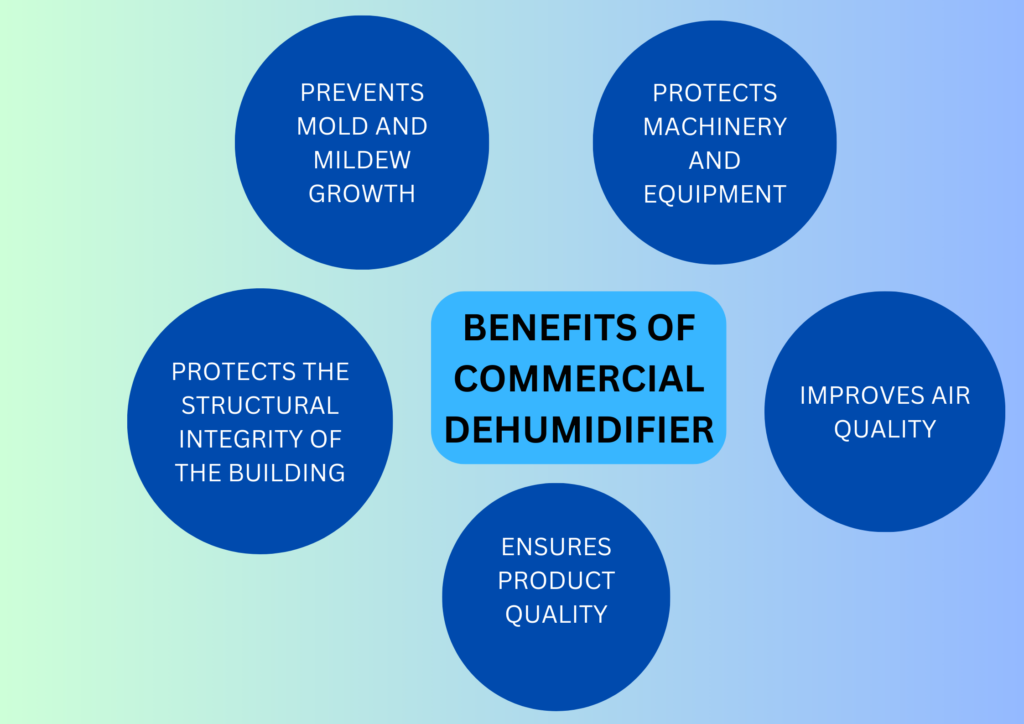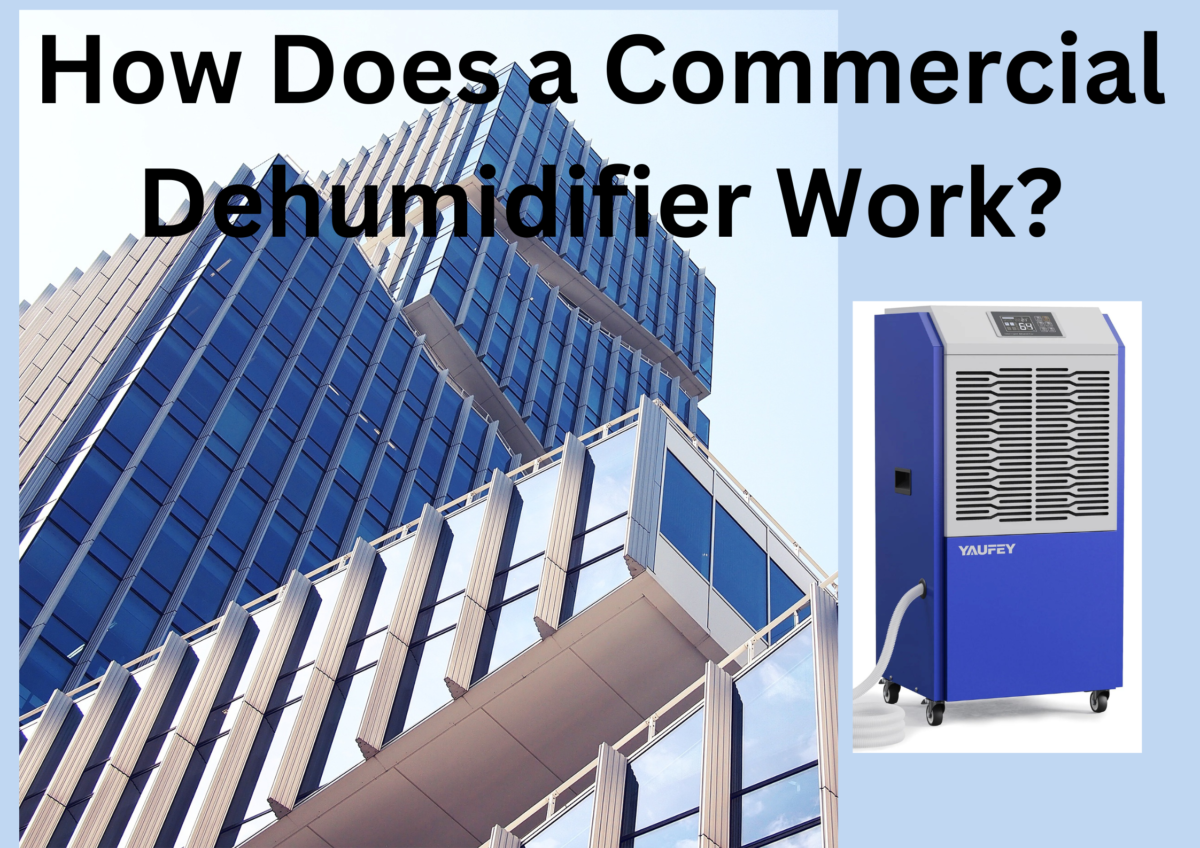Humidity is the amount of water vapor in the air. However, excess humidity in an indoor area affects both health and property and thus it can hurt your business. Mold growth, condensation, water damage, etc. are some of the most significant signs of excess moisture in your surrounding area.
Are you facing problems due to excess humidity inside your office, crawling space, or warehouse? A commercial dehumidifier can help you in this case. It removes excess humidity from a large space and maintains the humidity at a recommended level.
Confused about choosing a perfect commercial dehumidifier for your office? This article explains in detail about “How does a commercial dehumidifier work?”, the types of commercial dehumidifiers, their working principles, and their benefits.
Read this article to select the best commercial dehumidifier for your business.
What Is a Commercial Dehumidifier?
A commercial dehumidifier is an appliance that removes moisture from a large space such as a warehouse, a factory, a supermarket, a hospital, a large basement, or, another large commercial space. This dehumidifier maintains the humidity at a recommended level and improves the air quality of a large space. It is a powerful dehumidifier that can remove around 150 – 250 pints of moisture from the air per day.
According to the U.S. Environmental Protection Agency the ideal relative humidity level of the indoor air should be maintained between 30% to 50%.
Commercial dehumidifiers are bigger and heavier and they create loud noise during operation. These devices are designed using heavy-duty plastic or metal.
Commercial dehumidifiers are suitable for large areas affected by humidity, water leakage, flooding, etc. These devices are designed with hoses to drain out the water collected in the process.
Types of Commercial Dehumidifiers
There are mainly 3 types of commercial dehumidifiers available in the market.
- Refrigerant Dehumidifiers
Refrigerant dehumidifiers cool the humid air to the point at which the water vapor in the air starts condensing. The moisture or, water vapor in the air condenses into liquid water and later it is drained out of the room. The dry air free of moisture is then circulated back into the room.
2. Low Grain Refrigerant (LGR) Dehumidifiers
LGR dehumidifiers precool the humid air and then pass over the cool air through cold coils where condensation begins. This double-cooling process removes more water vapor from the humid air. Then the dry air supplies back into the room.
3. Desiccant Dehumidifiers
Desiccant dehumidifiers operate based on the principle of adsorption. The humid air passes through the constantly rotating desiccant wheel inside the device. The desiccant material on the wheel attracts water vapor in the air and releases dry air into the environment. The wheel again passes over warm air where the water on the wheel evaporates and the process continues to completely remove the moisture from the air.
How Does a Commercial Dehumidifier Work?
Working Principle of Refrigerant Dehumidifier
Businesses and sectors that use refrigerant commercial dehumidifiers:
- Product store and warehouses
- Large basements and garages
- Production areas
- Crawl spaces
- Indoor swimming pools
- Clothing drying rooms
- Vertical farming spaces
The step-by-step working procedure of a refrigerant dehumidifier is represented below.
- The basic working principle of this dehumidifier is based on the refrigerant mechanism.
- The fan draws in the humid air of an area to be dried.
- The humid air passes over the cold coils. The air is cooled to the point where the invisible water vapor begins to condense.
- In this process of condensation, the water vapor transforms into liquid water. The water is collected and then drained away from the room.
- The air free from moisture then passes over the warm coils and gets reheated to bring it back to its original temperature.
- The warm dry air is then circulated back into the room.
Working Principle of Low Grain Refrigerant (LGR) Dehumidifier
Businesses and sectors that use LGR dehumidifiers
- Water damage restoration
- Large construction drying project
- Drying dense material
The step-by-step working procedure of a Low Grain Refrigerant Dehumidifier is given below.
- The basic working principle of this type of dehumidifier is based on a double cooling mechanism.
- The LGR dehumidifier pre-cools the humid air once it comes inside the device.
- The double system of cooling lowers the temperature of moisture in the air.
- Once condensed the moisture in the air is collected as liquid water in the water tank. More condensation on the coils leads to more moisture pumped out.
- The air free from moisture is then reheated and warm dry air is then circulated inside the room.
Working Principle of Desiccant Dehumidifier
Businesses and sectors that use desiccant commercial dehumidifiers:
- Food packaging industry
- Storage facilities
- Preservation facilities, cold store facilities
- Boating
- Pharmaceuticals
The working principle of a desiccant commercial dehumidifier is represented below.
- The basic working principle of this dehumidifier is based on the adsorption mechanism.
- A fan is used to intake the humid air inside the device.
- The humid air passes over a constantly rotating desiccant wheel. The wheel is made up of desiccant material which attracts water vapor from the air onto it.
- The wheel then passes over a heated air stream which picks up the moisture on it and makes it dry again.
- The wheel is now reactivated and ready to remove the moisture from the air again.
- This process continues and the dry warm air recirculates back into the room.
- This device dehumidifies the air without using a refrigerant and in a sub-zero temperature and hostile environment.
Benefits of A Commercial Dehumidifier

Prevent Mold and Mildew:
Mold and mildew growth in commercial spaces damages expensive products and equipment. It also degrades the air quality, makes the environment hazardous for employees, and causes various health issues. A commercial dehumidifier prevents the growth of mold and mildew in large spaces including warehouses, storage units, basements, etc.
Protects Machinery and Equipment:
Excessive moisture in the air leads to mold growth which causes corrosion and rust on industrial machinery and equipment. This triggers breakdowns and expensive replacements. A commercial dehumidifier removes the excess moisture from a large space and protects the equipment from getting damaged. It increases the longevity and efficiency of the equipment.
Improves Air Quality:
The excess humidity in the air affects the health and well-being of employees. It Increases the dust and pollen in the surrounding air and triggers asthma and allergic symptoms. The installation of a commercial dehumidifier improves air quality and helps to build a healthier and more productive environment for employees.
Ensures Product Quality:
In the food processing and pharmaceutical industry, it is essential to maintain the humidity at the recommended level. The installation of a dehumidifier ensures the product quality and protects them from getting spoiled and losing effectiveness.
Protects The Structural Integrity of the Building:
A dehumidifier prevents condensation and protects the structural integrity of the building and its contents. It saves the walls, ceilings, and other surfaces from getting damaged due to water damage and mold growth.
Difference Between a Commercial Dehumidifier and a Residential Dehumidifier
| Commercial Dehumidifier | Residential Dehumidifier | |
| Size | Larger, heavier, and more robust | Compact and portable |
| Used in | Offices, crawl spaces, storage units, warehouses, hotels, industrial facilities | Bedroom, living room, basement |
| Capacity | Higher moisture extraction capacity | Lower moisture extraction capacity |
| Construction Material | Heavy-duty materials like steel | Plastic |
| Features | Remote controllers, programmable digital display, integrated pumps | Humidity level adjustment, timer setting, automatic shut-off, etc. |
| Noise level | Produce more noise | Minimal noise output |
| Regulatory Compliance | It has specific industry standards and regulations related to air quality and safety | No regulatory compliance. |

Commercial Dehumidifier Buying Guide: 10 Important Points
There are 10 major points that you should keep in mind while purchasing a commercial dehumidifier.
- Location and climate of the space
- The exact dimension of the space (in Length x Width x Height)
- The number of doors and windows in the space along with the door opening in minutes per hour
- Materials used in the construction of the space
- Degree of insulation
- Actual humidity level of the space
- Desired humidity level
- Number of people working inside that space
- Desired room temperature
- Average air temperature
Conclusion
Excess humidity inside a commercial space damages equipment and raw materials. In this case, a commercial dehumidifier maintains optimal humidity levels and protects valuable products from getting damaged. A clear explanation of the working principles of 3 main types of commercial dehumidifiers: refrigerant dehumidifiers, desiccant dehumidifiers, and LGR dehumidifiers is represented here.
Investing in a reliable dehumidifier improves the efficiency, productivity, and well-being of an industrial facility. This article also illustrates the 10 important points that should be considered while purchasing a commercial dehumidifier.
FAQS
- What size of commercial dehumidifier do I need?
The size of a commercial dehumidifier depends on 3 important things.
1. Cubic volume (Length x Width x Ceiling Height) of the space
2. Desired humidity level
3. Average air temperature
4. The number of doors and windows in the space along with the door opening in minutes per hour
5. Materials used in the construction of the space
6. Your Budget
2. How much does a commercial dehumidifier cost?
The cost of a commercial dehumidifier varies between 500$ and 2000$ depending on its features and the size of moisture removal.
Also Read
- How Does a Dehumidifier Work? Types, Uses, Benefits 2024
- 10 Tips for Buying a Dehumidifier
- Dehumidifier Vs Air Purifier 2024
- Dehumidifier vs. Air Conditioner 2024
- Cool Mist Humidifier: Types, Uses, Benefits, Working Principle 2024
- Do Humidifiers Help with Air Quality? 2024
- When Do You Need a Humidifier? 8 Common Signs
- How Do Humidifiers Work? A Complete Guide 2024
- How Humidifier Helps Breathing? 2024
- Humidifier Vs Dehumidifier Vs Air Purifier: Which One Should You Buy? 2024


18 thoughts on “How Does a Commercial Dehumidifier Work? Complete Overview”